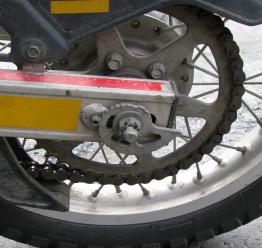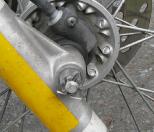Lesson 2 - checking stuff
So you've got your first bike from your brother-in-law, who swears it's totally roadworthy. Or you bought it brand-new from the dealer, where it was assembled by trained monkeys after being shipped from Japan in a box. Next week you're going to stick it between your legs and ride it in front of a 30-ton truck. Right.So, check some basic stuff before you take it anywhere:
- Frame - hard to check, but it should be rigid and free from cracks. Breaks in the paint and rust may indicate collision damage. If the frame is bent the bike won't steer in a straight line.
- Major bolts - swing arm, engine mounts, axle nuts etc. Should be tight.
If you can get a torque wrench and shop manual, check them explicitly.
I've had a swing arm nut fall off. In Canada, enough people must have lost
wheel nuts that the regulations call for a split pin fastener.


This photo shows the swing arm (rear fork) nut. No split pin on this one. It also shows a rusty area on a frame member. This kind of thing should be checked; in this instance it is on the rear peg support (not a critical frame member) and there is no cracking. - Tires - should be free from deep cuts and exposed belting. It's quite easy to check, compared with a car. Pressure should be reasonable (25-40 psi). Check the manual. Low pressure gives better traction off-road, but you can pull a valve out of the tube. Trials bikes clamp the tire to the wheel for this reason. Bike tires are crossply, with a tube. Never substitute a radial car tire.
- Engine oil level - small bikes don't have a warning light, and high-revving engines need good lubrication. If you run out of oil, the piston will seize in the cylinder, stopping the engine abruptly (pull in the clutch before you skid and lose it!). Then you will have to strip the engine, buy a new piston, and take the cylinder to a machine shop to be bored out. Been there, done that. My current bike has a window to check the level; see this photo. The bike should be upright (not leaning on the stand).
- Brakes - should work! The front brake should come on smoothly, and withstand the strongest grip you can manage without the lever being completely pressed to the handgrip. If hydraulic, the fluid level should be within limits. The disk pads or drum shoes should have adequate wear left. Small disk brakes wear down quite quickly. Scoring on the disk may indicate worn-out pads. It there is excessive scoring, you may need to replace or machine the disk. This photo shows one pad with quite a lot of wear left. There is some scoring on the disk, but not excessive.
- Lights - should work! The brake light should come on with either brake. The headlight should be adjusted correctly so the dipped beam touches the road maybe 50ft away. The flashers should work (in some jurisdictions, you can remove broken ones and use hand signals).
- Chain - should have about 3/8" of slack, be clean and lubricated. Drive sprocket teeth should be symmetric - uneven wear may indicate an over-stretched chain. Many bikes have O-ring sealed chain links, which are less prone to wear. Lubrication is a double-edged sword - too little, and the chain will wear. Too much, and it will attract grit, which will wear the chain.
- Steering - the handlebars should move smoothly from side to side without catching or making any noise. There should be no excessive play up-and-down or backwards-and-forwards.
- Spokes - should be evenly tensioned, and not loose or broken. The wheels should run true on the axles without excessive play in any direction. If you tap the spokes with a screwdriver, they should make the same pitched sound - "ping", not "clunk". A few loose spokes may be tightened easily enough, but serious re-tuning requires skill and a dial gauge.
- Engine. A reliable engine is nice to have. Engine work is beyond the scope of this tutorial, but if you can't trust the engine to deliver when you need it, you have cut your avoidance options in half.
- Loading - generally not an issue. But if you have a lot of luggage strapped on behind, it should be as far forward as possible, i.e. on the pillion seat. Too much weight on a rear rack will make the front wheel light and hard to control. Do not hang anything heavier than a couple of pounds from the handlebars. Do not fasten anything where it can swing into a wheel.